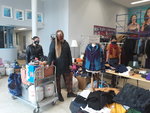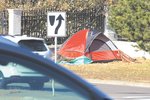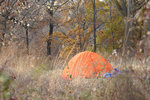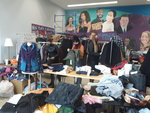



Whether working for the state, the city or on the front lines, workers addressing the homeless situation in Minnesota strongly agree on two things: affordable housing is desperately needed, and the COVID-19 pandemic greatly exacerbates the plight of the homeless.
Especially of concern with winter approaching is the number of individuals living in camps.
“The number of active encampments fluctuates regularly,” said Suzanne Donovan, with the Department of Safety and Inspection (DSI) for the city of Saint Paul. “In mid-to-late October, staff counted about 90 active encampments throughout Saint Paul, which can range in size from two to three tents to more.”
She said the city does not have a goal to “close” all encampments but is concerned about the welfare and safety of all individuals staying in encampments and in other outdoor spaces not intended as living quarters.
“The city is working with its partners to identify and secure safe indoor shelter space for all of our unsheltered residents,” Donovan said.
However, shelter space is decreasing due to COVID-19 spacing restrictions.
“It’s a systemic problem in that we don’t have enough homes that are affordable for people to live in,” said Minnesota Homeless Coalition (MHC) Executive Director Rhonda Otteson. “That is the big problem, and within that problem we have another issue that is systemic in that we don’t have enough shelter space for people to come indoors. COVID-19 has made that worse because social distancing is critical to the health and well-being of people staying in shelters, and shelters have needed to depopulate, a lot running at 50 percent capacity.”
Otteson added that means that other housing, such as hotels, have to be used. “We know it’s dangerous to be outside in the weather, but we also know people experiencing homelessness and staying in shelters are targets of violence, and it’s just not a safe space for anybody to be.”
‘People don’t want to be in shelters’
“Many people don’t want to be in shelters,” said April, a front-line worker who volunteers with St. Paul Camp Support, a group that collects donations of supplies for individuals and families living in outdoor encampments. “It has not been a dignified place for them, and they don’t feel respected at some of the shelters. One man told me he did not want to go to a shelter because to him it feels like a prison, and that is so valid.”
Donovan said that the city has been actively engaged with Ramsey County in working to stand up low-barrier overnight shelters as well as day space.
“There are several options in locations throughout the city under discussion, which would add to and expand existing capacity. These should offer alternatives, some with greater flexibility than more traditional congregate living spaces.”
Although the homeless encampments are mainly concentrated within the Metro, Otteson said homelessness is prevalent throughout the state. “I live in Willmar, and I know that it exists right here,” she stated. “It might not be so apparent, and it might be more hidden, but homelessness exists across our state.” She said that 80 out of 87 counties lack enough shelter beds.
Who are the homeless?
“Many are working or they have a chronic disability,” said Otteson. She added that half of the people experiencing homelessness in Minnesota are youth up to the age of 24.
“That really flips the switch for people when they think about who is homeless,” Otteson said. “And the other piece of this is that we have systemic racism that comes out and is exhibited in the data on homelessness. People of color are 10 times more likely than their White counterparts to be homeless.
“American Indian and African American populations are at particularly high disproportionate rates of homelessness, and so that is something that we may continue to keep an eye on. We need culturally specific solutions created in communities to best serve people.”
Otteson said that paying an unaffordable rent is the greatest factor to becoming homeless. “It creates this system of people being on the edge and being one car breakdown, one layoff, one sickness away from not being able to pay the rent. We have to do something about that.”
Otteson knows of what she speaks, as she experienced homelessness when she was growing up. “My mom had to take her three kids and stay with an aunt in a one-bedroom apartment.”
She said there is a lot of the same kind of doubling up happening today, but those informal arrangements are not preferred, particularly with the pandemic. “Just keeping that in mind, especially this time of year when it gets cold, people are making really hard choices about what they have to do to stay safe and stay well.”
Homes for All, coalitions
MCH, the organization Otteson leads, has its headquarters at 2233 University Ave. W. About 100 organizations across the state are members of MCH. “These organizations advance policy solutions on problems causing instability, and we really move the needle in creating homes in communities, the ultimate solution,” said Otteson.
MCH plays a key leadership role and a founding role in Homes for All (HFA), which has been operating for about eight years, according to Otteson. HFA is a coalition of 280 endorsing organizations across Minnesota that advocates for the continuance of housing resources.
“We carry HFA’s agenda on ours, submitting legislative items through that coalition because it is powerful and well known,” Otteson said. She noted that after five special sessions, the legislature finally passed a bonding bill. Otteson said the bonding investment of $116 million is the largest passed in the history of the state to preserve and create homes across Minnesota.
“This was a big win, when we have so many challenges,” Otteson said. She said the challenges are not only economical, but being an advocate during the current pandemic is difficult. “You can’t just walk up to the Capitol anymore.” She added that the new virtual environment and technology have created new space that MCH has embraced “because we have to.”
“It’s all about building that support for the (homelessness) issue, and with all the partners we come together as a community to advance these continued investments. We are going into one of the most challenging legislative sessions with our budget deficit not only in the current year, but in the next biennial. Advocates are preparing to have a strong presence and really engage because those who are most at risk should not have to bear the greatest burden in balancing our state budget.”
Camp Support collects donations
“It just sucks,” said April, the St. Paul Camp Support volunteer. “If there were enough housing so people could move on from shelters in a healthy time frame, it wouldn’t be so bad. But some people have been waiting for housing for seven years.”
St. Paul Camp Support collects donations at a building at 2161 University Ave. W., on Wednesdays and Fridays, 3-7 p.m. and Saturdays and Sundays 10 a.m.-2 p.m. “We are always looking for supplies, such as clothing, camp stoves, towels or tents.
“The camps are not good,” she said, “but some have been through this before and know how to survive.”
1 comment on this item Please log in to comment by clicking here
Neighborly
Is there any way we could use the Allianz Soccer Stadium, in the Midway? It has hygienic, private showers, locker rooms, plenty of large spaces for unhoused guests' belongings; is warm, has several full-service kitchens, and is easily staffed with safety and security volunteers, as it is during soccer matches. I think it would ease the burden of the Saint Paul Police as well as gain favor and blessing from the Minnesota United Football Club itself.
The facility is set back from the main streets for privacy, and volunteers would have access to heated underground parking. Seeing as the City will own and operate the property outright, this might be a step in the right direction for succoring are homeless. Interior spaces could be modified to host City departmental social services, located a few blocks away at Goodwill Easter Seals on Fairview Avenue and University. Also, all homeless would gain access to the Green Line train at Snelling Station should there be a need to rush to Regions Hospital or any type of employment interviews or job commitments.
The facility, which is new and outfitted with basic medical facilities as well as warmth, nourishment, and controlled access by skilled volunteers, is not to be used (according to the online calendar) until September 20201. I think we could put this facility to good use and save campers from a very harsh winter.
Friday, December 11, 2020 Report this